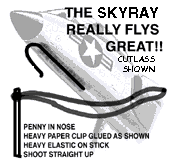



Douglas Skyray - $$5.50
The American Douglas F4D Skyray (later redesignated F-6 Skyray) was a carrier-based fighter built by the Douglas Aircraft Company. It was notable for being the first carrier-launched aircraft to hold the world's absolute speed record. Flies like a trooper catapulted by an elastic band.
The F4D Douglas Skyray-free downloadable cardmodel
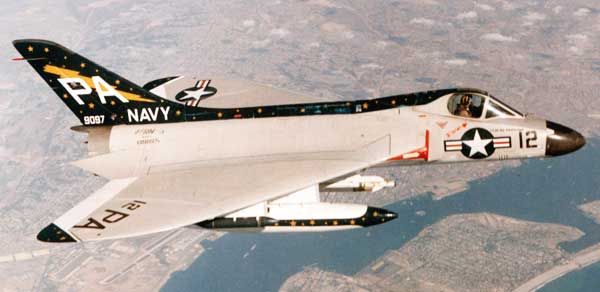
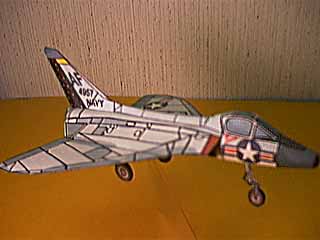
Based on German research, the Douglas people came up with this really neat aircraft that was designed for Navy carrier and Marine use exclusively. It featured a scintillating rate of climb for it's day.
German work on delta wing plan forms, directed by Dr Alexander Lippisch, led to a US Navy proposal in 1947 for a short-range carrier based interceptor fighter using a similar layout. Project studies were initiated by the Douglas design team led by Ed Heinemann with the object of producing a fighter optimized for a high rate of climb and capable of intercepting enemy aircraft before they reached their targets. These studies led to a design which, rather than being a pure delta, was a tailless aircraft with a sweptback wing of extremely low aspect ratio, and the Douglas designers thus followed Lippisch's own evolution of this layout for the Messerschmitt Me-163 target-defense interceptor.
Two prototypes of the Douglas design were ordered on December 16, 1948, as the XF4D-l, to be powered by the Westinghouse J40 turbojet. This engine suffered serious delays in development, and the XF4D-ls flew with 5,000 lb s.t. Allison J35-A-17 engines, the initial flight being made on January 23, 1951. Named Skyray, the F4D-1 was designed to carry an armament of four 20 mm cannon in the wings and, despite the interceptor role, was provided with six under wing strong points for bombs, rockets or drop tanks.
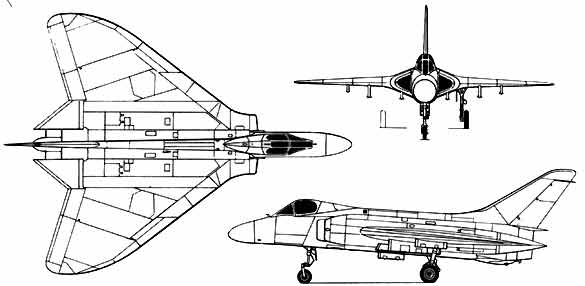 Both
prototypes of the Skyray subsequently flew with the 7,000 lb st.
XJ4O-WE-6 and the 11,600 lb (with afterburner) XJ4O-WE-8 engine,
but the failure of the J40 engine program led to a decision
in March 1953 to switch to the 14,500 lb (with afterburner) Pratt
& Whitney J57-P-2 in the production F4D-ls, orders for which
had already been placed.
Both
prototypes of the Skyray subsequently flew with the 7,000 lb st.
XJ4O-WE-6 and the 11,600 lb (with afterburner) XJ4O-WE-8 engine,
but the failure of the J40 engine program led to a decision
in March 1953 to switch to the 14,500 lb (with afterburner) Pratt
& Whitney J57-P-2 in the production F4D-ls, orders for which
had already been placed.
This airframe-engine combination flew for the first time on June 5, 1954, when the first production F4D-1 was completed. Three more aircraft were built in 1954, and 32 came off the line in 1955, but the first delivery to a Navy unit (VC-3) was not made until April 16, 1956, several flight-test problems having delayed acceptance of the aircraft.
With production building up rapidly, to nearly two a week in 1956 and nearly three a week in 1957, introduction of the Skyray to Navy and Marine units continued rapidly, and the aircraft proved to be a highly effective fighter once in service. Production ended in December 1958 with a grand total of 420 built, all in the basic F4D-1 version.
The Skyray was redesignated F-6A in September 1962, by which
time the type had been relegated to second-line duties and assigned
to Reserve Wings. A development of the same basic airframe with
a J57-P-14 engine and other changes was undertaken under the F4D-2
designation, but the four aircraft of this type which appeared
in 1956 and 1957 were redesignated F5D-1 before the first flight.
The F4D was arguably an attractive aircraft; it was unarguably
distinctive, different in appearance from any other jet fighter
ever put into operational service. It was of modified tailless
delta configuration, with rounded-off wings and a tail fin, but
no tailplane. The wing folded up outboard and featured inboard
and outboard leading-edge slats, plus inboard and outboard elevons.
There was a hydraulically-actuated airbrake on the rear of the
wing root, top and bottom on both sides, for a total of four airbrake's.
There were also guillotine-blade-shaped "pitch trimmer"
control surface on each side of the engine exhaust. The tail fin
was fitted with a two-section rudder.
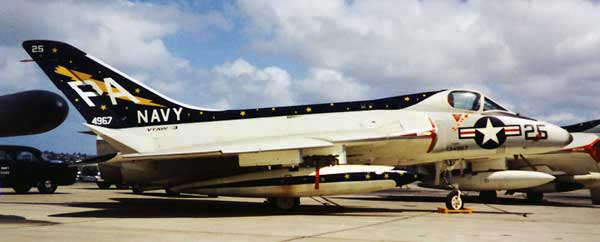
Makes up into a great little Navy model and the wings can be
easily made to fold. With a little hot melt glue, stretched
out paper clip, hearty rubber band, and utmost caution... you
can fly this little baby. Leave off the landing gear, it'll
just get wrecked.
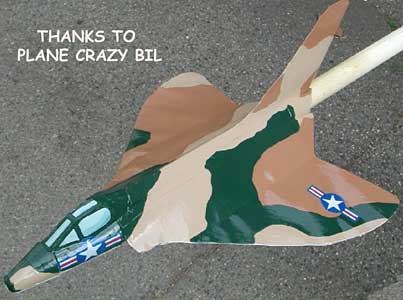 Hi
Chip & Company. I usually work in nothing thicker
than #67 cardstock but at the moment I am recovering
from a hand injury so as a challenge to myself I built
the Skyray in the attached pics out of #110 cardstock
to see if I could work with such thick material and
still have it come out nicely while in my condition.
Well as you can see aside from having to go very slowly
to be careful of my injury and a minor problem with
getting the scoring done correctly it came out better
than I had originally hoped for and I believe is somewhere
around 1/48th scale. Hi
Chip & Company. I usually work in nothing thicker
than #67 cardstock but at the moment I am recovering
from a hand injury so as a challenge to myself I built
the Skyray in the attached pics out of #110 cardstock
to see if I could work with such thick material and
still have it come out nicely while in my condition.
Well as you can see aside from having to go very slowly
to be careful of my injury and a minor problem with
getting the scoring done correctly it came out better
than I had originally hoped for and I believe is somewhere
around 1/48th scale.I then hand painted it using ordinary acrylic craft paints and added decals I printed up using inkjet decal paper (from decalpaper.com) since I am homebound and also that way was able to print up a wider variety of sizes for the markings in case I needed them. The camouflage paint scheme is my representation of what I thought it might have looked like if the Skyray had been kept in service long enough to see use early in the Vietnam War and I intentionally did not add any unit markings as I wanted a simpler look to show off the paint scheme. I finished it off with a high gloss clear coat (4 coats) for the final finish since the plane is for use a basic display model. It will eventually be joined by at least 2 other ones with an unusual paint scheme as somewhere online within the last year I found a picture of a Skyray in either inky black or very dark blue, which one it actually was I do not know so I am going to do one of each and park them flanking the camouflage Skyray. Thank you for your time and I hope that you enjoy the pics. Plane Crazy Bil,,Monrovia, California PS: When you consider that the Skyray was not phased out until sometime in 1962 to be replaced by the F4 Phantom and that the even older Skyraider was brought back into service for ground attack duty in Vietnam then a camo scheme Skyray kept around for the same use by either the Marines or the Air force is not too far fetched an idea. RE: flying as a glider.. Oh yeah it definitely is an airworthy model and I have seen repeated online mention of it being the favored glider model among model rocketry enthusiasts who praise it for the combination of simplicity and quality of the design, affordability and good flying characteristics. Personally I have flown a number of them myself, such activity including test flying a matched 1/72nd scale pair with the help of a friend last year in the Cajon Pass area of Southern California. We had heard of the organized model glider competitions held in the same general area and that led to our curiosity as to how well the Skyray models could do under certain conditions. Last fall on a reasonably cold day we went up there as we wanted to try the models without benefit of any ground thermals or tailwinds and used a location with around a 100 foot drop off and a clear view in all directions for verifying how far each plane went. The results were that each model flew well over 300 feet away with just a forward drop launch and was in the air for well over 15 seconds each time. We would have continued the testing a bit longer but as the overlook was also above some RR tracks on the last launch one model was pushed off course by the bow wave of air from a fast moving set of downhill bound helper engines and flew off course and out of sight. The other plane was pulled in by the tailwind of the same engines and got munched under the wheels of the next train to pass by a few minutes later. Ironically one of the most unusual Skyray incidents ever was on November 19th, 1958 when one over flew the end of the runway at the El Toro Marine Corps base in Orange County, ending up on the Santa Fe RR tracks, whereupon it was hit by Southbound passenger train #75 going by at 75MPH and as expected it resulted in a train wreck where all 3 engines and all 7cars derailed but there were only a few minor injuries and no fatalities. Bil |
|
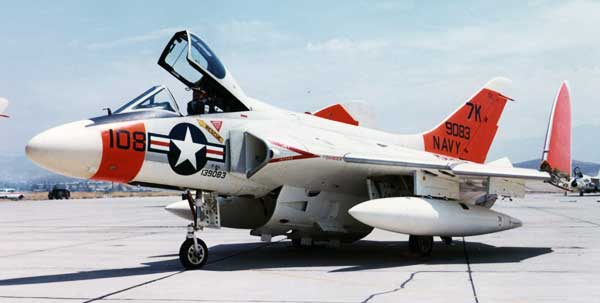
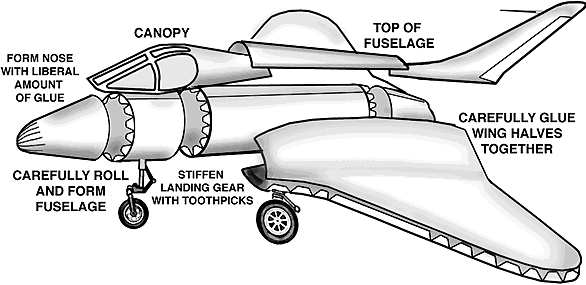
Two suggestions on how to rig your model
for flight. |
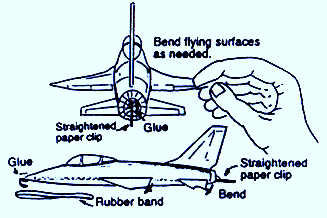 |
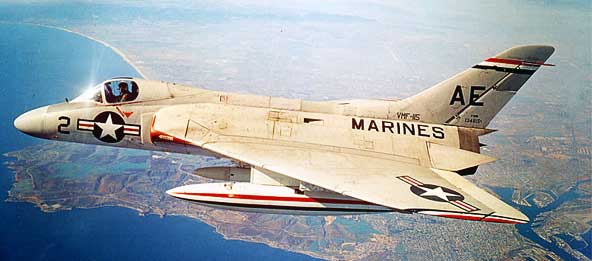
The Douglas Deltas
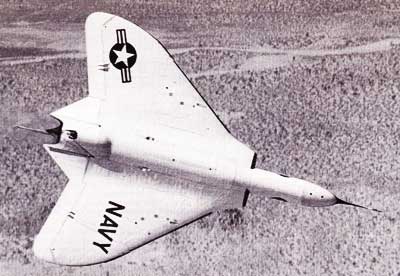
Delta wings do not have to be perfect triangles with acute base angles, as shown by the Avro Vulcan. Further, delta wings are not limited to use on tailless aircraft. The Douglas Aircraft Company of Long Beach, California, developed two major production models that illustrate both points well.
The first was the F4D Skyray, a carrier-based fighter
for the U.S. Navy. It flew in its XF4D-I prototype form on January
23, 1951, with a single 5,000pound thrust Allison J35 jet engine
substituting for the intended Westinghouse J40. The F4D featured
a combined fuselage/wing root structure that enclosed the large
engine and tapered sharply downward to the wing surface proper, which had the leading edge rounding
gently into the wingtip, and a rounded trailing edge at the tip
(FIGS. 4-} I, 4-12). The leading edge of the wing root was squared
off to provide dual air intakes for the engine. To reduce the
already short wingspan of 33 feet 6 inches for stowage on aircraft
carriers, the tips of the wing could be folded upward.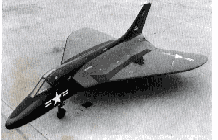
Altogether, 420 F4D-ls were delivered between June 1954andDecember 1958. The production F4D-I had a top speed of 695 mph from a later 9,700-pound thrust Pratt & Whitney J57 engine (10,500 pounds with afterburner). Armament was four 20mm cannon and up to 4,000 pounds of bombs, rockets, or other stores.
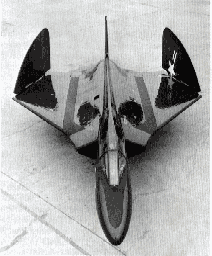
To combat the trend of single-seat combat designs toward greater size and weight, Douglas designer Edward H. Heinemann was charged in 1950 with the task of reversing the trend without decreasing combat capability. The result was the A4D-I Skyhawk, also called "Heinemann's Hot Rod" because of its performance. It was (and is) primarily a bomber and ground attack type, not a fighter. The XA4D-I prototype flew on June 22, 1954, with a Wright J65 (American-built British Armstrong-Siddeley Sapphire) engine. While it featured a classic delta wing with straight leading edges and sharp wingtips, it also had a horizontal tail (that in plan form was a smaller version of the wing), a big jet engine in the small fuselage, and little room for fuel in the thin 27 foot 6 inch wing. The bare Skyhawk was a short-range plane. Extra fuel could be carried in external drop tanks, and the new technique of aerial refueling by the hose-and-probe method (see Chapter 15) could extend the range indefinitely, leaving the under-wing racks available for military stores. Armament was two 20mm cannon and up to 500 pounds of bombs. Maximum speed at a gross weight of 24,500 pounds was 570 mph at sea level.
The A4D series (A-4 since 1962) established a most remarkable production record-some 2,960 were delivered between August 1954 and February 1979, a quarter-century of production for a first-line combat airplane. A switch to the 11,200-pound thrust Pratt &: Whitney J52 in 1957 resulted in the A4D-3 (later A4D). Skyhawk designations ultimately reached A-4M.
A-4E specifications:
Wing span 27 feet 6 inches;
area 260 square feet; gross weight 24,500 pounds; top speed 675
mph.
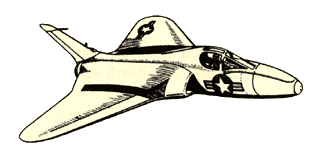
 These are just three of the versions included in your Skyray Collection folder thanks to Christoph Stahl/ 2009 |
I am the designer of the website http://www.hoxity.de/papercraft, also known as stahlhart papercraft. Fiddlersgreen. net is the reason I started doing my own build-able models after not building any plane models for over 10 years. Now I'm knee-deep in several projects. I think you are doing great work and are always an inspiration. Before I started with my first build-able model, the Douglas Skylancer, I did three repaints of Your F4D Skyray, the Skylancer's older brother. I made some slight modifications, most notably on the jet exhaust, where the wing should actually overlap the fuselage slightly. I also added extra parts to build open gear doors and weaponry. The Navy Blue version is a "what if"-version, while the other two are authentic. It's already more than one year ago, that I did those, and I thought it was about time to send them to you. Do with them what you please, change the text on them, or whatever you think useful. I hope You can release them in some way, for example in the Skyray folder, but it's up to you. Christoph Stahl |
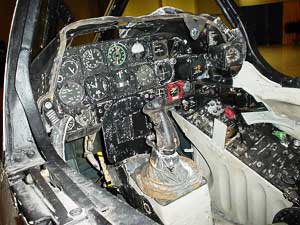 |
Douglas F4D Skyray Cockpit. |
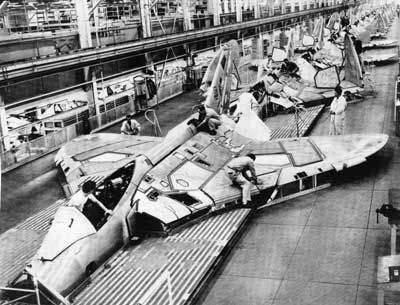 |
Douglas F4D Skyray Factory. |
Specifications
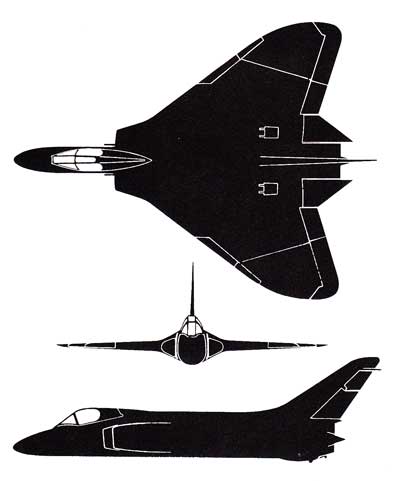 |
Length: 45 ft 3 in Wingspan: 33 ft 6 in Height: 13 ft Wing area: 557 ft² Empty weight: 16,024 lb Loaded weight: 22,648 lb Max takeoff weight: 27,116 lb Powerplant: 1× Pratt & Whitney J57-P-8, -8A or -8B turbojet Dry thrust: 10,200 lbf Thrust with afterburner: 16,000 lbf Performance Maximum speed: 722 mph Range: 700 mi combat Ferry range: 1,200 mi Service ceiling: 55,000 ft Rate of climb: 18,300 ft/min Wing loading: 41 lb/ft² Thrust/weight: 0.71 Armament Guns: 4 × 20 mm (0.79 in) Mk 12-0 cannons, two (2) each just aft of wing leading edge, mid-wing, underside, with 65 rounds/gun Rockets: 6 pods of 7 × 2.75 in (70 mm) unguided rockets or 4 pods of 19 × 2.75 in (70 mm) unguided rockets Missiles: 2 × AIM-9 Sidewinder air-to-air missiles Bombs: 2 × 2,000 lb (907 kg) bombs |
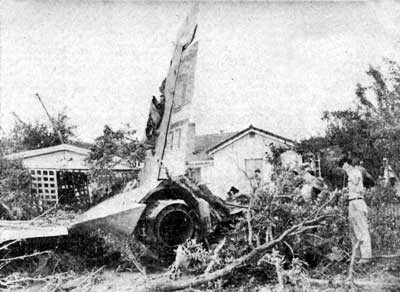 |
A Navy F4D1 Skyray jet bound for Moffett Field crashes near Cambrian Park. The pilot bailed out of the disabled aircraft, which crashed in the yard of a home at 15347 National Ave, about half a mile southeast of the San Jose-Los Gatos Rd. Fortunately, there were no injuries. |



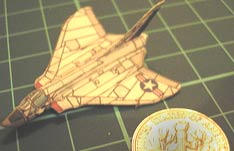 Dear
FG, I have enclosed pictures of my first ever weenie plane
and I think it's quite good. I would really like it
if you could publish it on the website. Yours Sincerely, Marcus Fenlon.
Dear
FG, I have enclosed pictures of my first ever weenie plane
and I think it's quite good. I would really like it
if you could publish it on the website. Yours Sincerely, Marcus Fenlon.